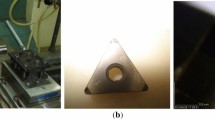Abstract
Geometry of cutting edge has great influence on performance and reliability of modern precision cutting tools. In this study, two-dimensional finite element model of orthogonal cutting of Fe–Cr–Ni stainless steel has been built to optimize the geometric parameters of chamfered edge. A method to measure the chip curl radius has been proposed. The effect of cutting edge geometric parameters on tool stress and chip curl radius has been analyzed. Then, the chamfered edge parameters have been optimized based on numerical simulation results. It finds that, keeping the equal material removal rate, the optimal geometric parameters of chamfered edge for rough machining Fe–Cr–Ni stainless steel are that the rake angle is from 16° to 17°, and the chamfer length is from 60 to 70 μm. Small (large) rake angle combined with small (large) chamfer length is more reasonable to reduce the tool stress. When the length of land is approximately equal to undeformed chip thickness and the rake angle is larger than 15°, the chip curl radius is minimal. The groove type with large radio of width to depth should be used in the chip breaking based on the optimization results.
Similar content being viewed by others
References
Cheng X, Zha X, Jiang F (2016) Optimizing the geometric parameters of cutting edge for rough machining Fe-Cr-Ni stainless steel. Int J Adv Manuf Technol 85(1–4):683–693
Jiang F, Yan L, Rong Y (2013) Orthogonal cutting of hardened AISI D2 steel with TiAlN-coated inserts—simulations and experiments. Int J Adv Manuf Technol 64(9–12):1555–1563
Maurel-Pantel A, Fontaine M, Thibaud S, Gelin JC (2012) 3D FEM simulations of shoulder milling operations on a 304 L stainless steel. Simul Model Pract Th 22:13–27
Choudhury IA, See NL, Zukhairi M (2005) Machining with chamfered tools. J Mater Process Tech 170(1–2):115–120
Carios Rodriguez CJ. (2009). Cutting Edge Preparation of Precision Cutting Tools by Applying Micro-abrasive Jet Machining and Brushing. (PhD Thesis), Kassel University, Kassel.
Khalili K, Safaei M (2009) FEM analysis of edge preparation for chamfered tools. Int J Mater Form 2(4):217–224
He G, Liu X, Wu C, Zhang S, Zou L, Li D (2015) Study on the negative chamfered edge and its influence on the indexable cutting insert's lifetime and its strengthening mechanism. Int J Adv Manuf Technol. doi:10.1007/s00170-015-7778-7
Ventura CEH, Köhler J, Denkena B (2015) Influence of cutting edge geometry on tool wear performance in interrupted hard turning. J Manuf Process 19:129–134
Bouzakis KD, Bouzakis E, Kombogiannis S, Makrimallakis S, Skordaris G, Michailidis N, Charalampous P, Paraskevopoulou R, M'Saoubi R, Aurich JC, Barthelmä F, Biermann D, Denkena B, Dimitrov D, Engin S, Karpuschewski B, Klocke F, Özel T, Poulachon G, Rech J, Schulze V, Settineri L, Srivastava A, Wegener K, Uhlmann E, Zeman P (2014) Effect of cutting edge preparation of coated tools on their performance in milling various materials. CIRP J Manuf Sci Technol 7(3):264–273
Al-Athel KS, Gadala MS (2011) The use of volume of solid (VOS) approach in simulating metal cutting with chamfered and blunt tools. Int J Mech Sci 53(1):23–30
Yang K, Liang Y, Zheng K, Bai Q, Chen W (2011) Tool edge radius effect on cutting temperature in micro-end-milling process. Int J Adv Manuf Technol 52(9–12):905–912
Bassett E, Köhler J, Denkena B (2012) On the honed cutting edge and its side effects during orthogonal turning operations of AISI1045 with coated WC-Co inserts. CIRP J Manuf Sci Technol 5(2):108–126
Denkena B, Biermann D (2014) Cutting edge geometries. CIRP Ann Manuf Technol 63(2):631–653
Liao T, Jiang F, Yan L, Cheng X (2016) Optimizing the geometric parameters of cutting edge for finishing machining of Fe-Cr-Ni stainless steel. Int J Adv Manuf Technol. doi:10.1007/s00170-016-8895-7
Zhao B, Shang H, Xin J (2014) The design and application of modern cutting tool (in Chinese). National Defense Industry Press, Beijing
Bil H, Kılıç SE, Tekkaya AE (2004) A comparison of orthogonal cutting data from experiments with three different finite element models. Int J Mach Tools Manuf 44(9):933–944
Jiang F, Li J, Sun J, Zhang S, Wang Z, Yan L (2010) Al7050-T7451 turning simulation based on the modified power-law material model. Int J Adv Manuf Technol 48(9–12):871–880
Yu J, Jiang F, Rong Y, Xie H, Suo T (2014) Numerical study the flow stress in the machining process. Int J Adv Manuf Technol 74(1–4):509–517
Jafarian F, Imaz Ciaran M, Umbrello D, Arrazola PJ, Filice L, Amirabadi H (2014) Finite element simulation of machining Inconel 718 alloy including microstructure changes. Int J Mech Sci 88:110–121
Ma J, Duong NH, Lei S (2015) 3D numerical investigation of the performance of microgroove textured cutting tool in dry machining of Ti-6Al-4 V. Int J Adv Manuf Technol 79:1313
Atlati S, Haddag B, Nouari M, Zenasni M (2014) Thermomechanical modelling of the tool–workmaterial interface in machining and its implementation using the ABAQUS VUINTER subroutine. Int J Mech Sci 87:102–117
Ceretti E, Filice L, Umbrello D, Micari F (2007) ALE simulation of orthogonal cutting: a new approach to model heat transfer phenomena at the tool-chip interface. CIRP Ann Manuf Technol 56(1):69–72
Jiang F, Zhang T, Yan L (2016) Estimation of temperature-dependent heat transfer coefficients in near-dry cutting. Int J Adv Manuf Technol 86:1207
Markopoulos AP (2013) Finite element method in machining processes. Springer, London
Wan L, Wang D (2015) Numerical analysis of the formation of the dead metal zone with different tools in orthogonal cutting. Simul Model Pract Th 56:1–15
Author information
Authors and Affiliations
Corresponding author
Rights and permissions
About this article
Cite this article
Cheng, X., Jin, S., Liao, T. et al. Optimizing the geometric parameters of chamfered edge for rough machining Fe–Cr–Ni stainless steel. Int J Adv Manuf Technol 91, 137–146 (2017). https://doi.org/10.1007/s00170-016-9736-4
Received:
Accepted:
Published:
Issue Date:
DOI: https://doi.org/10.1007/s00170-016-9736-4




